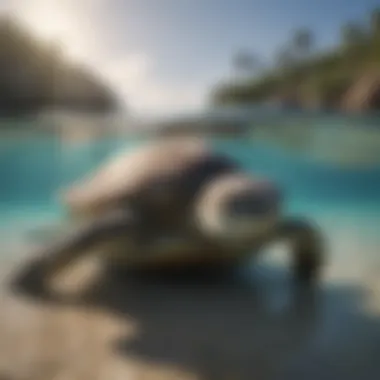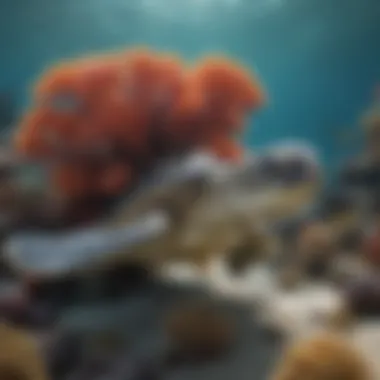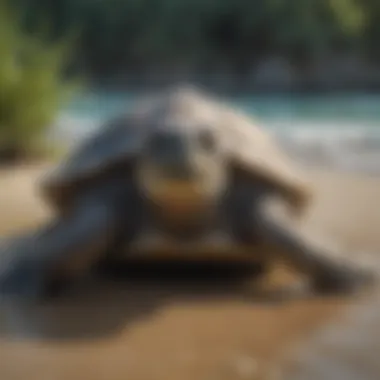Understanding the Natural Habitat of Sea Turtles


Intro
The natural habitat of sea turtles is intricate and critical for their survival. These magnificent creatures inhabit diverse ecosystems throughout their lives, ranging from warm coastal waters to the open ocean. Understanding the specific environments that sea turtles rely on enriches our knowledge of their ecological roles and underscores the necessity for proactive conservation efforts. The hurdles posed by human activities, such as plastic pollution and habitat destruction, put immense pressure on these species. Therefore, it is vital to explore the natural habitats of sea turtles in order to inform conservation strategies.
Animal Overview
Common Names
Sea turtles are commonly referred to by various names depending on their species. Some of the well-known names include:
- Green turtle
- Loggerhead turtle
- Hawksbill turtle
- Leatherback turtle
- Olive ridley turtle
Scientific Classification
Sea turtles belong to the family Cheloniidae and Dermochelyidae. The scientific classifications help categorize them into distinct species and families, fostering a deeper understanding of their biological characteristics. Some notable scientific names include:
- Chelonia mydas (Green turtle)
- Caretta caretta (Loggerhead turtle)
- Eretmochelys imbricata (Hawksbill turtle)
Geographic Range
Diverse in their geographic distribution, sea turtles inhabit oceans worldwide. They are particularly found in:
- Warm coastal waters
- Coral reefs
- Open oceans
- Nesting beaches along tropical and subtropical regions
These areas are essential for their life cycle, providing both foraging grounds and nesting sites.
Behavior and Social Structure
Social Behavior
Sea turtles exhibit a largely solitary nature. They usually gather in groups during mating or feeding. The social interactions can vary based on species and environment.
Communication
While not vocal communicators, sea turtles use body language and chemical cues to communicate with each other. Research suggests that these methods play a role during mating and interactions.
Mating and Reproduction
Mating typically occurs in shallow areas near nesting beaches. After mating, female sea turtles return to the beach where they were born to lay their eggs. This instinctual behavior is critical for survival, as the hatchlings have a better chance of finding suitable habitats close to their natal beach.
Habitat and Ecosystem
Natural Habitat
The natural habitat of sea turtles varies greatly. From feeding in seagrass beds to basking on sandy beaches, these habitats serve different purposes. Seagrass beds, for example, are crucial for species like the Green turtle, which primarily feeds on vegetation.
Food Sources and Diet
Sea turtles are generally classified by their diet:
- Herbivorous: Green turtles consume seagrasses and algae.
- Carnivorous: Loggerheads mainly eat jellyfish and crustaceans.
- Omnivorous: Hawksbills consume sponges and other marine invertebrates.
This dietary diversity aids in the health of marine ecosystems, as sea turtles help maintain the balance of their environments.
Role in Ecosystem
The ecological roles of sea turtles go beyond their feeding habits. They contribute to:
- Maintaining seagrass health by grazing, which promotes growth.
- Supporting fish populations by providing habitat for smaller marine species.
- Enhancing nutrient cycles through their nesting activities along beaches.
The loss of sea turtle populations could lead to significant shifts in marine ecosystems, underlining the urgency of conservation efforts.
In summary, sea turtles are integral to marine ecosystems. Understanding their habitats and behaviors is crucial for developing effective conservation strategies. Enhancing awareness about the impact of human activities on these habitats is essential for preserving the health of our oceans and the future of sea turtles.


Foreword to Sea Turtles
Sea turtles are extraordinary creatures. They have inhabited the planet for millions of years. Understanding their natural habitat is crucial for several reasons. First, it helps us appreciate their role in the marine ecosystem. Second, it informs conservation efforts needed to protect them. The more we know, the better we can act.
Biological Overview of Sea Turtles
Sea turtles belong to the order Chelonii. There are seven species, each with unique adaptations. Their bodies are streamlined for swimming. This design helps them navigate vast oceanic expanses. Unlike land turtles, sea turtles are unable to retract their heads into their shells.
The primary biological functions of sea turtles include foraging, nesting, and migration. They thrive in diverse habitats, ranging from coral reefs to open oceans. Sea turtles possess a remarkable ability to return to their nesting sites. Their life cycle shows a complex interaction with marine environmental factors.
Importance of Sea Turtles in Marine Ecosystems
Sea turtles function as keystone species in marine environments. Their grazing helps maintain the health of seagrass beds, which are vital for marine life. By controlling seaweed populations, they promote biodiversity.
Key Contributions of Sea Turtles:
- Nutrient Cycling: Sea turtles contribute to nutrient cycling within their habitats.
- Habitat Maintenance: Their feeding activities encourage growth in seagrass and coral reef ecosystems.
- Biodiversity Support: By facilitating a rich marine environment, sea turtles indirectly support various marine species.
Sea turtles' presence is crucial to keeping marine ecosystems in balance. Without them, the complexity of these habitats may diminish.
Recognizing the significance of sea turtles ensures that conservation efforts are effectively directed. Their survival is intertwined with the health of our oceans.
Defining Natural Habitat
Defining natural habitat is a crucial aspect of understanding the ecosystems in which sea turtles thrive. Their habitats range from coastal zones to open oceans. Not just locations, these habitats encompass all the ecological elements that sustain sea turtles, facilitating their reproduction, feeding, and migration. Understanding these nuances assists conservationists in implementing effective protection strategies and ensuring the longevity of these ancient reptiles.
Key Characteristics of Sea Turtle Habitats
Sea turtle habitats possess several distinct characteristics:
- Diverse environments: Sea turtles inhabit a variety of ecosystems such as sandy beaches, coastal lagoons, coral reefs, and open ocean.
- Temperature regulation: Each habitat offers specific temperature ranges, critical for the development of eggs and the overall health of turtles.
- Food sources: Different habitats provide unique food options, from sea grasses in shallow waters to jellyfish in deeper parts of the ocean.
- Shelter and Safety: Coastal areas often serve as nesting sites, while certain marine environments provide refuge from predators.
These elements collectively enhance the understanding of how sea turtles interact with their surroundings and establish the significance of each habitat in their life cycle.
Differences in Habitat Across Species
Different species of sea turtles exhibit unique habitat preferences, which reflect their ecological niches. For example:
- Loggerhead turtles predominantly occupy temperate waters, often found in areas rich in crustaceans and mollusks.
- Green turtles, which primarily feed on sea grasses, are typically found in coastal regions and lagoons that offer abundant marine flora.
- Leatherback turtles, the largest of all, prefer colder open ocean waters and feed mainly on jellyfish.
This variation highlights the adaptability of sea turtles in inhabiting diverse aquatic environments, allowing for a rich study on how habitat traits correlate with species behavior and survival.
Understanding these differences is essential for tailored conservation efforts aimed at protecting specific species and their unique ecological needs.
Coastal Habitats
Coastal habitats are crucial for the survival and well-being of sea turtles. These regions serve multiple roles throughout a turtle's life, especially during nesting and feeding. They provide the necessary environmental conditions that support various species of turtles. Moreover, understanding these habitats can aid in the conservation efforts that protect both turtles and their ecosystems.
Nesting Sites and Their Importance
Nesting sites are vital for the reproduction of sea turtles. Female sea turtles journey thousands of kilometers to return to the same beaches where they were born, showing a remarkable instinct for site fidelity. The quality of these nesting sites directly influences hatchling survival rates. Factors such as sand temperature, sediment composition, and the availability of suitable nesting locations can affect whether eggs will thrive or fail.
Additionally, coastal areas must be kept intact and free from overly invasive human activities. Development, pollution, and beach lighting can deter females from nesting or negatively impact hatchling orientation towards the ocean. Conservation efforts must focus on protecting these crucial sites. Organizations are implementing measures like restricting access during nesting seasons and educating communities about the importance of these locations.
In some areas, nesting sites are monitored using technological approaches, such as beach restoration projects and tracking programs. Such initiatives have shown promise in increasing the success rates of nesting.
Feeding Grounds: Sea Grasses and Coral Reefs
Sea turtles, as herbivorous or omnivorous creatures, rely substantially on their feeding grounds, which often include sea grasses and coral reefs. Sea grasses offer rich nutrition, serving as an essential food source for species like the green sea turtle. These underwater meadows support the health of local ecosystems, providing habitat for various marine organisms and contributing to the overall biodiversity.
Coral reefs are another significant feeding ground. They harbor diverse communities of fish and invertebrates which sea turtles feed upon. The health of coral reefs is integral to the turtles' survival. If these reefs are compromised due to pollution or climate change, the feeding opportunities for turtles diminish, leading to potential starvation.
Conservationists are actively addressing threats to both sea grasses and coral reefs. Strategies include promoting sustainable fishing practices, protecting marine parks, and restoring damaged ecosystems. The connection between healthy feeding grounds and thriving sea turtle populations cannot be overstated, making these areas a focal point in habitat conservation efforts.
The protection of coastal habitats is essential for securing the future of sea turtles and preserving the intricate ecosystems they inhabit.


In summary, coastal habitats are indispensable to sea turtles. By recognizing the significance of nesting sites and feeding grounds, we can take informed steps to ensure these creatures thrive for generations to come.
Open Ocean Habitats
Open ocean habitats represent a vital realm in the life of sea turtles. These vast marine areas provide crucial resources, influencing the behavioral patterns and survival of various species. Sea turtles often migrate long distances between feeding and nesting grounds, traversing these open waters. Understanding these habitats is essential for comprehending how human activities and natural phenomena affect turtle populations.
Migration Patterns of Sea Turtles
Sea turtles exhibit fascinating migration patterns that are essential for their life cycles. These migrations are often linked to specific life stages, reproductive cycles, and the availability of food sources. Most sea turtles migrate hundreds to thousands of miles. For example, the loggerhead turtle typically migrates from its nesting sites to feeding areas located far from shore.
The timing of these migrations varies between species and is influenced by environmental factors such as water temperature and currents. Younger turtles tend to remain in coastal areas, while adults venture into deeper oceanic waters. This behavior ensures they access the necessary nutrients and reduces competition.
Studies show that sea turtles have an innate ability to navigate vast distances, using the Earth’s magnetic fields as a guide. This remarkable skill ensures they find their way back to specific nesting sites, often year after year.
Yearly migrations allow sea turtles to access different feeding grounds. For instance, green turtles often seek out sea grasses, while leatherback turtles prefer jellyfish blooms. Migration and feeding behaviors are closely linked; for example, turtles may stage their migrations based on the availability of prey.
Impact of Ocean Currents on Habitat Distribution
Ocean currents significantly shape the distribution of habitats where sea turtles thrive. These currents determine the direction and flow of water, which in turn affects temperature, salinity, and nutrient availability. Understanding these currents is crucial when examining sea turtles’ feeding areas, migration routes, and overall survival.
Sea turtles are influenced by surface currents, which can make their long journeys easier or more challenging. For example, when a current is favorable, turtles may conserve energy while migrating over long distances. In contrast, adverse currents can lead to increased energy expenditure and might impact their ability to find food or return to nesting sites.
Additionally, ocean currents affect the broader marine ecosystem. They help distribute larvae and nutrients, supporting diverse marine life that sea turtles prey upon. If these currents change due to climate factors, it can have a ripple effect on food availability and, consequently, turtle populations.
In summation, open ocean habitats are integral to the lifecycle of sea turtles. Migration patterns reveal their behavioral adaptations and survival strategies, while ocean currents illustrate the dynamic interactions that influence these magnificent creatures' habitat distribution. Both elements highlight how interconnected these ecosystems are and the urgent need to protect them.
Threats to Sea Turtle Habitats
The habitats of sea turtles are under increasing threat from a variety of human activities. Understanding these threats is crucial for developing effective conservation strategies. Climate change, pollution, and overfishing present multi-faceted challenges that influence not just the turtles themselves, but the wider marine ecosystems that they inhabit. Addressing these threats requires a commitment from various stakeholders, including governments, conservation organizations, and local communities. Every effort matters when it comes to safeguarding the delicate balance of marine life.
Climate Change and Its Effects
Climate change stands out as a significant threat to sea turtle habitats. Rising sea temperatures can negatively impact the health of coral reefs, which are vital feeding areas. Furthermore, the increase in ocean acidity affects the availability of prey, making it difficult for turtles to thrive.
Another alarming aspect of climate change is the effect on nesting areas. Rising sea levels threaten to submerge critical nesting grounds. Many species, such as the loggerhead turtle, rely on specific beaches for nesting. If these beaches disappear, it could lead to declines in the population. Moreover, altering weather patterns can result in more frequent and intense storms, which further erode nesting habitats.
Pollution: A Growing Concern
Pollution is another pressing threat to sea turtle habitats. Oceanic debris, particularly plastic waste, poses a danger to turtles who often mistake plastics for food. Ingesting plastic can lead to severe health implications, including intestinal blockage and malnutrition.
Chemical pollutants also compromise marine ecosystems. These toxins can accumulate in the bodies of sea turtles, affecting their reproductive health and overall fitness. Oil spills in particular, which occur due to drilling activities, can have devastating effects not only on turtles but the entire marine environment. Efforts to reduce pollution, therefore, become essential for turtle conservation and for maintaining the integrity of their habitats.
Overfishing and Habitat Degradation
Overfishing adds to the strain on sea turtle habitats. The depletion of fish populations affects the food sources critical to the survival of turtles. Without adequate feeding grounds, species like the green turtle, which primarily consumes seagrass, face nutritional deficits.
Additionally, fishing practices often result in habitat degradation through destructive techniques such as bottom trawling. This method damages seagrass beds and coral reefs, further eroding the essential structures that support vibrant marine life. The incidental catch of sea turtles in fishing gear, known as bycatch, also poses a significant risk. International cooperation is needed to implement sustainable fishing practices that ensure both fish and turtle populations can coexist.
Managing these threats is already challenging, and neglecting them risks jeopardizing marine ecosystems. Each action taken towards understanding the threats can lead to a more sustainable future for sea turtles and their habitats.
Conservation Efforts
The conservation efforts for sea turtles are crucial in safeguarding their natural habitats. These creatures face numerous threats that compromise not only their well-being but also the ecosystems they occupy. Conservation is not solely about maintaining the populations of sea turtles; it extends to protecting their breeding grounds, feeding areas, and migratory pathways. By understanding and addressing the factors that threaten their survival, we can ensure a more sustainable future for these species and the environment they inhabit.
International Regulations and Agreements
International cooperation is vital for the protection of sea turtles. Various treaties and agreements aim to create frameworks for the conservation of marine wildlife. A major agreement is the Convention on International Trade in Endangered Species of Wild Fauna and Flora (CITES). This treaty regulates international trade in endangered species, including several species of sea turtles. Countries that are signatories to this pact commit to ensure that trade does not threaten the survival of these animals.
Additionally, the Inter-American Convention for the Protection and Conservation of Sea Turtles focuses specifically on sea turtle conservation. This agreement brings together nations in the Americas to coordinate efforts in protecting these animals and their habitats. These international regulations help establish standards for sea turtle conservation and encourage collaboration among nations.
Key International Efforts
- Global Sea Turtle Conservation Strategy: A framework for region-specific actions.
- Regional Fisheries Management Organizations: Collaborate to minimize bycatch in fishing.
- UN Sustainable Development Goals: Guarantee the preservation of marine life, including sea turtles.


These agreements underline the importance of collective action. Protecting migratory species, such as sea turtles, requires cooperation that transcends national borders.
Local Initiatives and Community Engagement
Local initiatives play a significant role in the conservation of sea turtle habitats. Community engagement is essential for successful conservation efforts. Many regions have developed local programs that educate the public about the importance of sea turtles. These initiatives often involve collaboration between local communities, NGOs, and government entities.
An example is the involvement of communities in nesting site protection. Many coastal communities participate in beach clean-ups and monitor nesting sites during the breeding season. These efforts help reduce disturbances to nesting turtles and improve hatching success rates. Further, local awareness campaigns create a proactive approach toward conserving these animals.
Benefits of Community Engagement
- Enhanced Local Knowledge: Local communities gain insights on the ecological importance of sea turtles.
- Empowerment: Communities feel a sense of ownership over their environment, increasing participation.
- Sustainable Practices: Local economies can benefit from eco-tourism, diverting effort from harmful activities.
The Role of Technology in Habitat Conservation
Technology plays a significant role in the conservation of sea turtle habitats. It offers innovative solutions to complex problems. The integration of technology into conservation efforts enhances our ability to monitor, protect, and restore these vital ecosystems. Advances in tracking, data collection, and habitat restoration are reshaping how we approach the protection of sea turtles and their environments.
Tracking and Monitoring Sea Turtles
Tracking sea turtles is crucial for understanding their behavior and habitat use. Modern technologies such as GPS and satellite tracking provide real-time data on turtle migrations and their interaction with the environment. These tools allow researchers to gather detailed information about specific locations where turtles feed, nest, and migrate. By analyzing movement patterns, scientists can identify critical habitats that require protection.
The data obtained from tracking also helps in assessing the impact of environmental changes. For instance, scientists can monitor how shifts in ocean temperatures or the presence of pollutants affect turtle migration routes. This information is essential for developing effective conservation strategies that ensure these species can thrive.
Key technologies in tracking sea turtles include:
- GPS tracking devices: These provide precise location data.
- Satellite transmitters: These give global coverage for tracking long migrations.
- Acoustic telemetry: This method is useful for monitoring turtles in specific coastal regions.
Innovative Approaches to Habitat Restoration
Habitat restoration for sea turtles often requires a multi-faceted approach. New technologies enhance traditional methods in several ways. One such approach involves using drones for aerial surveys to map out habitats. Drones can collect high-resolution images of nesting sites or important feeding areas. This data allows for better planning in conservation efforts.
Another innovative method includes the use of artificial intelligence to analyze large sets of ecological data. AI can identify patterns and trends that may be overlooked by human observers. This leads to more targeted interventions in habitat preservation.
Additionally, community involvement is now facilitated by mobile applications that allow users to report sightings and data about sea turtles. This creates an engaged network of citizen scientists who contribute to data collection, expanding the reach and effectiveness of conservation initiatives.
In summary, technology acts as a powerful ally in habitat conservation for sea turtles. The use of advanced tracking systems and innovative restoration techniques transforms traditional conservation practices. With continued advancements, we can enhance our efforts to protect these remarkable creatures and their habitats.
Future Directions in Sea Turtle Habitat Research
Emerging Areas of Study
Future studies on sea turtle habitats should consider diverse aspects:
- Genetic Research: Investigating genetic diversity can help understand how populations adapt to changing environments.
- Impact of Microplastics: New studies on how microplastics affect sea turtles' health and habitat choices are crucial. This includes evaluating ingestion and habitat contamination.
- Climate Impact Models: Developing models to predict the effects of climate change allows scientists to create proactive conservation plans. Areas such as temperature changes, nesting site erosion, and food source availability should be studied in detail.
- Satellite Technology: Utilizing satellite imagery can improve tracking migration patterns. This data will inform how habitat use changes and adapt in response to climate shifts.
Research in these areas can provide valuable insights into the behavior of sea turtles in an ever-changing world.
Collaboration Between Scientists and Conservationists
Cooperation between scientists and conservationists is vital for securing the future of sea turtle habitats.
Collaborative efforts can lead to more effective solutions that directly impact conservation outcomes.
The synergy between academic institutions, government bodies, and local communities enhances knowledge sharing and resource allocation. Here are some key elements of successful collaboration:
- Data Sharing: Pooling research data increases the understanding of sea turtle movements and habitat use. Open access to data allows for more comprehensive studies that consider diverse phenomena.
- Community Involvement: Engaging local communities in research initiatives fosters stewardship of habitats. Educating these communities leads to increased awareness and support for conservation efforts.
- Joint Conservation Projects: Partnerships in habitat restoration projects can maximize resources and expertise. Collaborative approaches often yield better results than isolated efforts.
- Funding Opportunities: Combined efforts can attract funding from both public and private sectors. A unified voice can strengthen proposals to secure necessary financial support.
Overall, fostering collaboration will play a significant role in advancing research and enhancing the conservation of sea turtle habitats.
Culmination
The significance of preserving the natural habitat of sea turtles cannot be understated. The ecosystems that support these ancient mariners are vital not only for the turtles themselves but also for the overall health of marine environments. Sea turtles contribute to the marine ecosystem by maintaining the health of seagrasses and coral reefs, which are crucial for numerous other species.
The Long-Term Importance of Habitat Preservation
Long-term habitat preservation is essential for ensuring that sea turtles can thrive. This means protecting their nesting sites, feeding grounds, and migratory pathways. As previously outlined, sea turtles are highly migratory, traveling vast distances across oceans. This behavior complicates conservation efforts, making it critical to implement protective measures on a global scale.
Maintaining healthy habitats supports the biodiversity that benefits from them. Without adequate conservation, we risk losing not just sea turtles but many other species that share the same environments. The interdependent relationships within marine ecosystems exemplify the complexity of life under the sea.
Call to Action for Conservation Efforts
It is now imperative to rally for strong conservation initiatives. Communities, organizations, and individuals must work together to advocate for policies that protect sea turtles and their habitats. Support for international treaties, local regulations, and grassroots initiatives is essential to bolster these efforts.
You can contribute to conservation by participating in beach clean-ups, promoting awareness about pollution, or supporting wildlife protection organizations. Every small act contributes to a larger movement toward safeguarding these incredible creatures.
Preserving the natural habitat of sea turtles is not just an ecological responsibility; it is our ethical duty. We must act now to secure a future for these magnificent beings and the ecosystems they inhabit.







